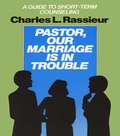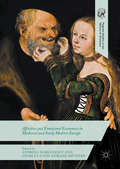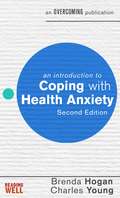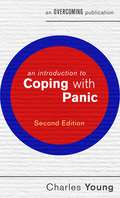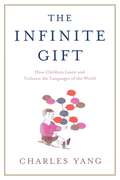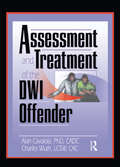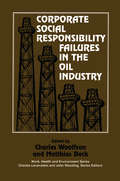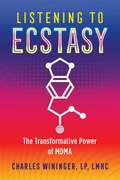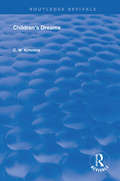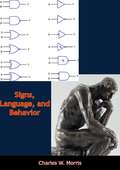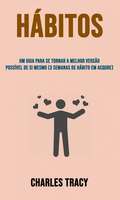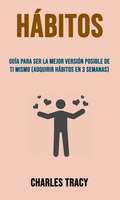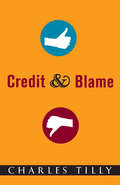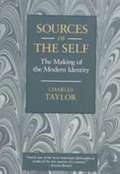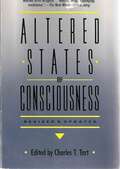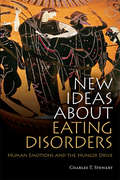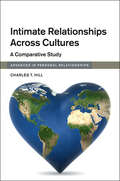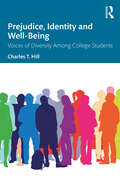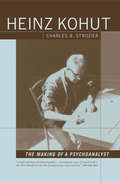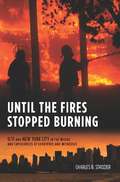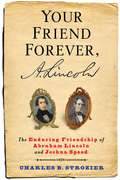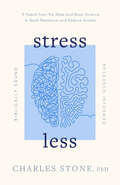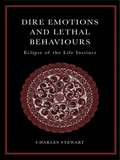- Table View
- List View
Attachment Centred Therapy: Therapeutic Practice With Attachment Issues (Palgrave Texts in Counselling and Psychotherapy)
by Charley ShultsThis textbook provides a detail guide to the use of Attachment Centred-Therapy (ACT), a model designed over the course of three decades which enables future and present therapists to co-construct a more coherent narrative of a person’s life, an essential indicator of one’s emotional and mental health. This book provides students and practitioners undergoing professional development with a detailed and applicable guide to using the model, written by the man who designed and developed the therapy. As such, this book is based on real world experience of the implementation of therapy, considering theory and research, and demonstrates how ACT can be used in applications across a wide range of clinical contexts. The purpose of ACT is to help those undergoing therapy equip themselves with new resources which can assist in dealing with their predominate issues by changing how they process information about the past in the present, to achieve a better outcome in the future. ACT is a growth-oriented psychotherapy, designed using Maslow’s Modified Hierarchy of Needs as a guide, and is distinctive because it utilizes the Adult Attachment Interview (AAI) as both an assessment instrument and as a vehicle for therapeutic intervention. Another of its benefits is that it’s a collaborative treatment, with the therapist forming a team with the therapy’s recipient, and then engaging together in a joint effort to create a more coherent narrative of the past, and to correct errors in information processing. This textbook is made up of practical guidance on the application of ACT, with each concept brought to life with case-study examples, complete with sections of dialogue from sessions annotated to illustrate the methods. It will provide a valuable new teaching tool for teachers and students of systemic practice, family therapy, clinical psychology, counselling, and psychotherapy, alongside qualified practitioners, and practitioners in training.
Pastor, Our Marriage Is in Trouble: A Guide to Short-Term Counseling
by CharlesL. RassieurActing with genuine care and concern, pastors can be effective in helping married couples resolve difficulties and discover reconciliation, joy, and love. The question often is, “How do I do it?” In Pastor, Our Marriage Is in Trouble, Charles L. Rassieur, an experienced counselor, outlines a step-by-step approach that takes the pastor from beginning to end in a process of short-term intervention and counseling. A helpful tool in the process is the Pastoral Marriage Counseling Questionnaire, which can be used in gathering essential information about both spouses and their relationships. In addition, you’ll find important information about: a rationale for the need and opportunity for pastoral intervention in troubled marriages how the marriage counseling process begins with the initial pastoral contact with one or both spouses help for the pastor in preparing for individual counseling sessions with each spouse important topics for marriage counseling regardless of which approach or model is used the last two sessions of counseling: deciding whether to end counseling, to refer the couple to other professional resources, or to contract with the couple for further counseling sessions
Affective and Emotional Economies in Medieval and Early Modern Europe (Palgrave Studies in the History of Emotions)
by Andreea Marculescu Charles-Louis Morand MétivierThis book analyzes how acts of feeling at a discursive, somatic, and rhetorical level were theorized and practiced in multiple medieval and early-modern sources (literary, medical, theological, and archival). It covers a large chronological and geographical span from eleventh-century France, to fifteenth-century Iberia and England, and ending with seventeenth-century Jesuit meditative literature. Essays in this book explore how particular emotional norms belonging to different socio-cultural communities (courtly, academic, urban elites) were subverted or re-shaped; engage with the study of emotions as sudden, but impactful, bursts of sensory experience and feelings; and analyze how emotions are filtered and negotiated through the prism of literary texts and the socio-political status of their authors.
An Introduction to Coping with Health Anxiety, 2nd edition: A Books on Prescription Title
by Brenda Hogan Charles YoungLearn how to control your health anxietyHealth anxiety affects many people across the world - a preoccupation with physical illness that is equally bad for your mental health. This self-help guide explains how it develops and what keeps it going. This updated edition gives you clinically proven cognitive behavioural therapy (CBT) techniques to help you challenge the way you think and behave:· How to spot and challenge thoughts that make you anxious· Reducing your focus on your body and on illness
An Introduction to Coping with Panic, 2nd edition
by Charles YoungLearn how to manage your feelings of panic Panic disorder and panic attacks affect many people across the world. This self-help guide explains how panic develops and what keeps it going. This updated edition gives you clinically proven cognitive behavioural therapy (CBT) techniques to help you recognise the link between your thoughts and your panic:How to spot and challenge thoughts that make you panicKeeping a panic diaryLearn calming breathing techniques
The Infinite Gift: How Children Learn and Unlearn the Languages of the World
by Charles YangA child's very first word is a miraculous sound, the opening note in a lifelong symphony. Most parents never forget the moment. But that first word is soon followed by a second and a third, and by the age of three, children are typically learning ten new words every day and speaking in complete sentences. The process seems effortless, and for children, it is. But how exactly does it happen? How do children learn language? And why is it so much harder to do later in life?Drawing on cutting-edge developments in biology, neurology, psychology, and linguistics, Charles Yang's The Infinite Gift takes us inside the astonishingly complex but largely subconscious process by which children learn to talk and to understand the spoken word. Yang illuminates the rich mysteries of language: why French newborns already prefer the sound of French to English; why baby-talk, though often unintelligible, makes perfect linguistic sense; why babies born deaf still babble -- but with their hands; why the grammars of some languages may be evolutionarily stronger than others; and why one of the brain's earliest achievements may in fact be its most complex. Yang also puts forth an exciting new theory. Building on Noam Chomsky's notion of a universal grammar -- the idea that every human being is born with an intuitive grasp of grammar -- Yang argues that we learn our native languages in part by unlearning the grammars of all the rest. This means that the next time you hear a child make a grammatical mistake, it may not be a mistake at all; his or her grammar may be perfectly correct in Chinese or Navajo or ancient Greek. This is the brain's way of testing its options as it searches for the local and thus correct grammar -- and then discards all the wrong ones. And we humans, Yang shows, are not the only creatures who learn this way. In fact, learning by unlearning may be an ancient evolutionary mechanism that runs throughout the animal kingdom. Thus, babies learn to talk in much the same way that birds learn to sing. Enlivened by Yang's experiences with his own young son, The Infinite Gift is as charming as it is challenging, as thoughtful as it is thought-provoking. An absorbing read for parents, educators, and anyone who has ever wondered about the origins of that uniquely human gift: our ability to speak and, just as miraculous, to understand one another.
Assessment and Treatment of the DWI Offender
by Charles Wuth Alan A CavaiolaWork more effectively with DWI offenders!This valuable book provides current information on the psychological, social-demographic, and psychiatric characteristics of DWI offenders. It also will provide you with up-to-date assessment strategies that can be employed with offenders, who characteristically are resistant to such assessment. Until now, books written on this subject have focused purely on research that has been done with offenders. This book, however, provides both theoretical and applied strategies for working with this very difficult population in clinical/treatment settings. Assessment and Treatment of the DWI Offender provides practical treatment approaches such that will help you manage client resistance and incorporate family members and significant others into the treatment process to more effectively treat offenders.Assessment and Treatment of the DWI Offender examines: the important variables that separate DWI offenders from alcoholics in general, as well as the “normal” population patterns of drinking behavior among offenders the magnitude of the DWI problem in the United States the history of the DWI countermeasures movement prevention and public education organizations such as SADD, MADD, the Partners in Progress program, the College Binge Drinking Initiative, and more enforcement techniques like breath testing, standardized field sobriety tests, on-site drug detection devices, etc. problems with the tools and techniques that are currently being used to address this issue interviewing techniques that work with DWI offenders more!Intended primarily for counselors, social workers, psychologists, and other professionals who work with DWI offenders and packed with helpful and easy-to-read statistical charts and tables, this book is also essential for graduate students in psychology, social work, chemical dependency, or any of the helping professions.
Corporate Social Responsibility Failures in the Oil Industry
by Charles Woolfson and Matthias BeckCorporate Social Responsibility Failures in the Oil Industry directly challenges the oil industry's claims of corporate good citizenship, now widely advanced as part of a global public relations initiative. The volume spans the industry's reach, from the troubled waters of the UK offshore Continental Shelf, with its horrendous legacy of the Piper Alpha oil rig disaster, to the inhospitable shores of Newfoundland with its own tragic legacy of lost lives; to the new frontier of oil corporate colonialism in the former Soviet Union and the icy plains of Alaska. The central theme of violations of basic labour rights and of health and environmental protection standards will make uncomfortable reading in the boardroom. It is equally essential reading for those who seek to improve the position of workers and industries within the oil industry's global reach.
Listening to Ecstasy: The Transformative Power of MDMA
by Charles WiningerA personal narrative and guide to the safe, responsible use of MDMA for personal healing and social transformation • Details the author&’s 50 years of responsible experimentation with mind-altering substances and how Ecstasy has helped him become a better therapist • Explains how he and his wife found Ecstasy to be the key to renewing and enriching their lives and marriage as they entered their senior years • Describes what the experience actually feels like and provides protocols for the safe, responsible, recreational, and celebrational use of MDMA for individuals and groups In a world that keeps us separate from each other, MDMA is the chemical of connection. Aptly known in popular culture as &“Ecstasy,&” MDMA helps us rediscover our own true loving nature, often obscured by the traumas of life. On its way to becoming a prescription medication due to groundbreaking research on its use to treat PTSD, Ecstasy can offer benefits for all adult life stages, from 20-somethings to seniors. In this memoir and guide to safe use, Charles Wininger, a licensed psychoanalyst and mental health counselor, details the countless ways that Ecstasy has helped him become a better therapist and husband. He recounts his coming of age in the 1960s counterculture, his 50 years of responsible experimentation with mind-altering substances, and his immersion in the new psychedelic renaissance. He explains how he and his wife found Ecstasy to be the key to renewing and enriching their lives as they entered their senior years. It also strengthened the bonds of their marriage. Countering the fearful propaganda that surrounds this drug, Wininger describes what the experience actually feels like and explores the value of Ecstasy and similar substances for helping psychologically healthy individuals live a more &“optimal&” life. He provides protocols for the responsible, recreational, and celebrational use of MDMA, including how to perfect the experience, maximize the benefits and minimize the risks, and how it may not be for everyone. He reveals how MDMA has revitalized his marriage, both erotically and emotionally, and describes how pleasure, fun, and joy can be profound bonding and transformative experiences. Revealing MDMA&’s versatility when it comes to bringing lasting renewal, pleasure, and inspiration to one&’s life, Wininger shows that recognizing the transformative power of happiness-inducing experiences can be the first step on the path to healing.
Children's Dreams (Routledge Revivals)
by Charles William KimminsOriginally published in 1920, Children's Dreams offers a rough classification of the type of dream peculiar to children of different ages, showing the variation from year to year and the influence of the environment. Considering children's dreams according to different age brackets ranging from five to eighteen years of age, and also considering the dreams of deaf and blind children, this book understands the important part played by the unconscious in the child's normal behaviour and recognises its educational value.
Signs, Language, and Behavior
by Charles W. MorrisFor the past twenty years Charles Morris has collected and co-ordinated the major developments in the field of communication, from the physical sciences to the arts, with the intention of formulating a comprehensive, reliable theory of signs. The result is this significant achievement that deserves to rank with the work of Ogden and Richards, Korzybski, and P. W. Bridgman. Signs, Language, and Behavior is not only an invaluable tool for the semantic specialist, but because it reaches into their domains it is of vital interest to scientists, philosophers, linguists, sociologists, psychologists, psychiatrists, educators, critics of the arts--to all, in fact, concerned with problems of meaning, language, and communication. For Dr. Morris considers signs in a wide variety of contexts: in relation to truth and belief, to poetry, religion, literature, morality, philosophy, and especially with reference to the individual in the contemporary world faced with interpreting and appraising the many complex signs around him.
Hábitos (3 Semanas De Hábito Em Acqure): Guia Para Se Tornar a Melhor Versão de Si Próprio
by Charles TracyEste não é um simples livro de ensino. É um roteiro de sucesso através de um sistema educacional que se está tornando cada vez mais difícil de navegar. O livro irá expor as falsidades e desinformações de que os professores estão a ser bombardeados todos os dias, tal como revelará os segredos do que realmente interessam para criar uma carreira feliz e gratificante. O livro contém as melhores estratégias para o ajudar a criar a vida que você tanto deseja. É baseado em ciência, neurociência, psicologia positiva e exemplos da vida real. Contém os melhores exercícios para criar rapidamente o impulso para uma vida mais feliz, saudável e enriquecedora. Teve mais de 180 000 vendas e downloads desde Março que foram traduzidos para o Alemão, Russo, Japonês, Coreano, Chinês e muitas outras línguas. A autora quer que você trabalhe com este livro e faça disso uma prioridade para implementar estes hábitos na sua vida. Todas as semanas receberá um novo desafio que se alargará e o aproximará da pessoa que você quer ser. Cada hábito constrói-se por si próprio para que no final do ano tenha todas as ferramentas que necessita para se tornar imparável! Está á espera de quê? Não espere mais! Deslize o rato para cima e clique no botão "comprar agora" para começar a jornada para a vida dos seus sonhos!
Hábitos: Guía Para Ser La Mejor Versión Posible De Ti Mismo (Adquirir Hábitos En 3 Semanas)
by Charles TracyÉste no es un libro de enseñanza ordinario. Es un mapa con ruta al éxito, a través de un sistema educativo que se está volviendo cada vez más difícil de navegar. Expondrá las falsedades y la mala información con la que los profesores han sido bombardeados cada día y revelará los secretos que realmente importan para formar una profesión feliz y realizada. El libro contiene las mejores estrategias para ayudarte a crear la vida que quieres. Está basado en ciencia, neurociencia, psicología positiva y ejemplos de la vida real y contiene los mejores ejercicios para rápidamente crear un impulso hacia una vida más feliz, sana y adinerada. Tiene más de 180,000 ventas y descargas desde Marzo y ha sido traducido a diferentes idiomas incluidos el Alemán, Ruso, Japonés, Coreano, Chino, entre otros. Ella quiere que trabajes a través de este libro y lo conviertas en una de tus prioridades principales para implementar estos hábitos en tu vida. Cada semana recibirás un nuevo desafío que te acercará a la persona que quieres ser. Cada hábito se construirá sobre sí mismo para que al final del año, tengas todas las herramientas necesarias para ser imparable. ¿Qué estás esperando? ¡No esperes más! ¡Presiona el botón de comprar ahora para iniciar el viaje a la vida de tus sueños!
Credit and Blame
by Charles TillyIn his eye-opening book Why?, world-renowned social scientist Charles Tilly exposed some startling truths about the excuses people make and the reasons they give. Now he's back with further explorations into the complexities of human relationships, this time examining what's really going on when we assign credit or cast blame. Everybody does it, but few understand the hidden motivations behind it. With his customary wit and dazzling insight, Tilly takes a lively and thought-provoking look at the ways people fault and applaud each other and themselves. The stories he gathers in Credit and Blame range from the everyday to the altogether unexpected, from the revealingly personal to the insightfully humorous--whether it's the gushing acceptance speech of an Academy Award winner or testimony before a congressional panel, accusations hurled in a lover's quarrel or those traded by nations in a post-9/11 crisis, or a job promotion or the Nobel Prize. Drawing examples from literature, history, pop culture, and much more, Tilly argues that people seek not only understanding through credit and blame, but also justice. The punishment must fit the crime, accomplishments should be rewarded, and the guilty parties must always get their just deserts. Brilliantly conceived and masterfully written, Credit and Blame is a book that revolutionizes our understanding of the compliments we pay and the accusations we make.
The Politics of Collective Violence
by Charles TillyAre there any commonalities between such phenomena as soccer hooliganism, sabotage by peasants of landlords' property, incidents of road rage, and even the events of September 11? With striking historical scope and command of the literature of many disciplines, this book seeks the common causes of these events in collective violence. In collective violence, social interaction immediately inflicts physical damage, involves at least two perpetrators of damage, and results in part from coordination among the persons who perform the damaging acts. Professor Tilly argues that collective violence is complicated, changeable, and unpredictable in some regards, yet that it also results from similar causes variously combined in different times and places. Pinpointing the causes, combinations, and settings helps to explain collective violence and its variations, and also helps to identify the best ways to mitigate violence and create democracies with a minimum of damage to persons and property.
Sources of the Self: The Making of the Modern Identity
by Charles TaylorIn this extensive inquiry into the sources of modern selfhood, Charles Taylor demonstrates just how rich and precious those resources are. The modern turn to subjectivity, with its attendant rejection of an objective order of reason, has led--it seems to many--to mere subjectivism at the mildest and to sheer nihilism at the worst. Many critics believe that the modern order has no moral backbone and has proved corrosive to all that might foster human good. Taylor rejects this view. He argues that, properly understood, our modern notion of the self provides a framework that more than compensates for the abandonment of substantive notions of rationality. The major insight of Sources of the Self is that modern subjectivity, in all its epistemological, aesthetic, and political ramifications, has its roots in ideas of human good. Sources of the Self provides a decisive defense of the modern order and a sharp rebuff to its critics.
Altered States of Consciousness
by Charles T. TartCombining the best of the humanistic and scientific traditions, this book covers the effects of drugs, yoga, self-hypnosis, mutual hypnosis, meditation, brainwave feedback, and dream consciousness. As the author states in his introduction: "The 1980s have been thought of as a conservative time. With respect to consciousness exploration by individuals in point of fact such exploration is still very much with us. It will stay with us, for better or worse, because of dissatisfaction with the limitations of our culture."
New Ideas about Eating Disorders: Human Emotions and the Hunger Drive
by Charles T. StewartIn this book, Charles Stewart discusses how the positive affects of the life instinct such as interest and joy, and the crisis affects such as fear, anguish, rage, shame and contempt, condition and can even dissociate the hunger drive, thereby contributing to either positive or negative attitudes toward eating. New Ideas About Eating Disorders presents clinical case studies of individuals from infancy to adulthood suffering from various eating disorders, a new theory as to their etiology, and suggestions for treatment and prevention. This book will be essential reading for all professionals engaged in caring for patients experiencing an eating disorder and for those developing theories to deepen our knowledge of these disturbances. It will also be of interest to those in the field of analytical psychology, as well as anyone wanting to know how contemporary affect theory can help us understand eating and its disorders.
Intimate Relationships across Cultures: A Comparative Study (Advances in Personal Relationships)
by Charles T. HillIntimate relationships exist in social domains, in which there are cultural rules regarding appropriate behaviors. But they also inhabit psychological domains of thoughts, feelings, and desires. How are intimate relationships experienced by people living in various types of romantic or sexual relationships and in various cultural regions around the world? In what ways are they similar, and in what ways are they different? This book presents a cross-cultural extension of the findings originating from the classic Boston Couples Study. Amassing a wealth of new data from almost 9,000 participants worldwide, Hill explores the factors that predict having a current partner, relationship satisfaction, and relationship commitment. These predictions are compared across eight relationship types and nine cultural regions, then uniquely combined in a Comprehensive Partner Model and a Comprehensive Commitment Model. The findings test the generalizability of previous theories about intimate relationships, with implications for self-reflection, couples counseling, and well-being.
Prejudice, Identity and Well-Being: Voices of Diversity Among College Students
by Charles T. HillThis essential and timely text looks at the ways in which various identities are socially constructed by students, exploring and comparing multiple dimensions of diverse identities, and the various ways students try to fit in when faced with prejudice and discrimination. Based on more than 20 years of data collected from Multiple Identities Questionnaires, plus Self-Identity papers in the author’s Diverse Identities course, this book gives voice to the diverse and intersectional identities experienced by students at a formative time in their lives. Analyzing data from more than three thousand college students, the book gives a uniquely comprehensive overview of identity formation, stigma, prejudice, and discrimination, which are part of conflict around the world. Author Charles T. Hill asks to what extent the students have experienced prejudice or discrimination regarding each of their identities, their own prejudice and discrimination toward others of each identity, and the importance of each type of identity for their self-concept. Split into three sections: the first part of the book gives an overview of terminologies and theoretical concepts, the second part explores the multiple dimensions of each identity using data from the MIQ interspersed with quotes from Self-Identity papers, and the third part compares and combines the different types of identities. Introduced with a foreword by Professor Emeritus of Africana Studies James M. Jones, the book opens a space to help students and others explore their identities, realize that they are not alone in their struggles with prejudice, and accept themselves with pride in their identities. Featuring highlighted key concepts and self-reflection sections, as well as further reading, measures, and statistical results, this book is essential not only for undergraduate and graduate students in social psychology, health psychology, sociology, ethnic studies, and social work, but also for therapists, parents, teachers and practitioners running Diversity Training Programs for non-students.
Heinz Kohut: The Making of a Psychoanalyst
by Charles StrozierHeinz Kohut (1913-1981) stood at the center of the twentieth-century psychoanalytic movement. After fleeing his native Vienna when the Nazis took power, he arrived in Chicago, where he spent the rest of his life. He became the most creative figure in the Chicago Institute for Psychoanalysis, and is now remembered as the founder of 'self psychology,' whose emphasis on empathy sought to make Freudian psychoanalysis less neutral. Kohut's life invited complexity. He obfuscated his identity as a Jew, negotiated a protean sexuality, and could be surprisingly secretive about his health and other matters. In this biography, Charles Strozier shows Kohut as a paradigmatic figure in American intellectual life: a charismatic man whose ideas embodied the hope and confusions of a country still in turmoil. Inherent in his life and formulated in his work were the core issues of modern America. The years after World War II were the halcyon days of American psychoanalysis, which thrived as one analyst after another expanded upon Freud's insights. The gradual erosion of the discipline's humanism, however, began to trouble clinicians and patients alike. Heinz Kohut took the lead in the creation of the first authentically home-grown psychoanalytic movement. It took an emigre be so distinctly American. Strozier brings to his telling of Kohut's life all the tools of a skillful analyst: intelligence, erudition, empathy, contrary insight, and a willingness to look far below the surface.
Until the Fires Stopped Burning: 9/11 and New York City in the Words and Experiences of Survivors and Witnesses
by Charles StrozierCharles B. Strozier's college lost sixty-eight alumni in the tragedy of 9/11, and the many courses he has taught on terrorism and related topics since have attracted dozens of survivors and family members. A practicing psychoanalyst in Manhattan, Strozier has also accepted many seared by the disaster into his care. In some ways, the grief he has encountered has felt familiar; in other ways, unprecedented. Compelled to investigate its unique character further, he launched a fascinating study into the conscious and unconscious meaning of the event, both for those who were physically close to the attack and for those who witnessed it beyond the immediate space of Ground Zero.Based on the testimony of survivors, bystanders, spectators, and victim's friends and families, Until the Fires Stopped Burning brings much-needed clarity to the conscious and unconscious meaning of 9/11 and its relationship to historical disaster, apocalyptic experience, unnatural death, and the psychological endurance of trauma. Strozier interprets and contextualizes the memories of witnesses and compares their encounter with 9/11 to the devastation of Hiroshima, Auschwitz, Katrina, and other events Kai Erikson has called a "new species of trouble" in the world. Organizing his study around "zones of sadness" in New York, Strozier powerfully evokes the multiple places in which his respondents confronted 9/11 while remaining sensitive to the personal, social, and cultural differences of these experiences. Most important, he distinguishes between 9/11 as an apocalyptic event (which he affirms it is not;rather, it is a monumental event), and 9/11 as an apocalyptic experience, which is crucial to understanding the act's affect on American life and a still-evolving culture of fear in the world.
Your Friend Forever, A. Lincoln: The Enduring Friendship of Abraham Lincoln and Joshua Speed
by Charles StrozierOn April 15, 1837, a "long, gawky" Abraham Lincoln walked into Joshua Speed's dry-goods store in Springfield, Illinois, and asked what it would cost to buy the materials for a bed. Speed said seventeen dollars, which Lincoln didn't have. He asked for a loan to cover that amount until Christmas. Speed was taken with his visitor, but, as he said later, "I never saw so gloomy and melancholy a face." Speed suggested Lincoln stay with him in a room over his store for free and share his large double bed. What began would become one of the most important friendships in American history.Speed was Lincoln's closest confidant, offering him invaluable support after the death of his first love, Ann Rutledge, and during his rocky courtship of Mary Todd. Lincoln needed Speed for guidance, support, and empathy. Your Friend Forever, A. Lincoln is a rich analysis of a relationship that was both a model of male friendship and a specific dynamic between two brilliant but fascinatingly flawed men who played off each other's strengths and weaknesses to launch themselves in love and life. Their friendship resolves important questions about Lincoln's early years and adds significant psychological depth to our understanding of our sixteenth president.
Stress Less: 9 Habits from the Bible and Brain Science to Build Resilience and Reduce Anxiety • Biblically Sound • Research Informed
by Charles StoneWe&’re living in a stressed-out world. According to a poll from the American Psychological Association more than a quarter of U.S. adults say they&’re so stressed they can&’t function. But it&’s not just adults. Teenagers and children are also experiencing the negative effects of stress. Blending brain science, biblical truth, and best practices, Stress Less provides hope and healing. From his PhD research, pastor Charles Stone presents nine actionable insights for those battling stress or who have friends or family with fear and anxiety. Stone writes about biblical characters who successfully and unsuccessfully navigated stress and shares how he&’s responded to the stresses in his life, including a cancer diagnoses, heart issue, pre-diabetes diagnosis, and depression.Stone answers the questions: What is stress?What does stress do to the body and brain?How do we build resistance to stress? He shows how changes in thinking, feeling, sleep, spiritual practices, and relationships can help us thrive through life&’s stresses. Readers learn how gratitude and soaking your soul in Jesus can cultivate a life of greater well-being and joy. While we can&’t eliminate the stressors of life, we can learn to navigate them with courage and grace. This timely resource is a practical guide for anyone who feels the creep of stress, who desires freedom and peace, and who wants to Stress Less.
Dire Emotions and Lethal Behaviours: Eclipse of the Life Instinct
by Charles StewartDire Emotions and Lethal Behaviours explores the primary motivational system in human beings. Based on the work of C. G. Jung, James Hillman, Louis Stewart and Silvan Tomkins, Charles Stewart investigates the psychology of the innate affects, with a focus towards the emotional motivation of adolescents and young adults who have killed others, themselves, or both. It is suggested that social isolation, dissociation of the personality, unbearable emotions, and possession by affects are necessary conditions for both homicide and suicide. Stewart argues that these conditions result from deep-seated emotional psychopathology which involves both the positive affects of the life instinct - Interest and Joy, and the crisis affects - Fear, Anguish, Anger, and Shame/Contempt. Illustrated throughout with case studies of individuals who have committed homicide, suicide, or both, Dire Emotions and Lethal Behaviours aims to discover the emotional motivations for such behaviours so that through education and psychological treatment, such tragic outcomes can be prevented. This book will be of interest to professionals and students in the fields of mental health and criminal justice.

